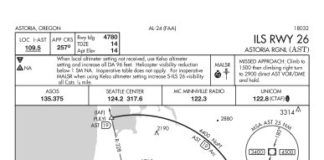It had been a fun morning. The heater had broken in the TRACON radar room. It was 20 degrees outside, not much better inside, and the hot chocolate I was drinking was losing its steam—literally. On top of that, busy last-minute holiday traffic had been giving our morning skeleton crew a kick in the teeth.
A Beechcraft King Air checked in. He’d just departed a local uncontrolled field VFR and was requesting a pop-up IFR clearance to New Orleans at FL180. Since he had nothing on file, it was up to me to punch his info into the computer and assign him a routing.

The situation brought to mind a question an IFR reader had asked recently. He’d read my previous article on how ATC handles pop-ups, and had wondered: when the pilot doesn’t have a filed route, how do controllers determine the routing to issue when the flight will cross various facilities’ airspace?
I was tired and cold. Would I make the King Air bear the brunt of my misery and get a long routing for my own amusement, as punishment for not filing? Would I toss a few darts at an IFR chart on the wall and just clear him via wherever they stuck? In a few discussions I’ve shared with pilots over the years, several have half-jokingly (half?) suggested that’s exactly how we come up with our route assignments.
Routes can vary from the ridiculously simple to the downright convoluted. Given that there aren’t actually any personal vendettas or sharp pointy things involved in their selection, just how do controllers conjure them up?
Get In, Get Out
ATC’s routing philosophy is simple: issue the shortest safe and legal route available. We examine each flight’s route on a case-by-case basis. If we’re able to clear an aircraft from point A to B “via direct” without needing to assign additional fixes, navaids, arrival procedures, or airways, then we do. This economy of routing is mutually beneficial.
Chances are, unless a pilot’s on a sightseeing flight or doing instrument navigation training, he wants to get to his destination as quickly as possible. Controllers aren’t in the business of intentionally making pilots jump through unnecessary hoops. We know shorter routes equal less time and money spent, reduce navigational complexity, and minimize wear on the airplane and pilot.
Time-saving routes are self-serving for ATC as well. It’s in our best interest to get the airplane out of our airspace as fast as possible. The less time you’re in our airspace, the less time we have to be responsible for your safety. Does that sound like we’re dodging responsibility? It’s actually quite the opposite.
Our controller mandate is to provide for the “safe, orderly, and expeditious flow of aircraft.” By ensuring an aircraft doesn’t hit anything, falls in line with other airplanes—who are also not hitting things—and continues to its destination with minimal delay, we’ve accomplished our job.
We also take workload into account. If you’re one of a dozen airplanes on my frequency, you’re getting a twelfth of my attention. The sooner you fly out of my airspace, the more attention I have left to give my remaining traffic. If I give you a roundabout routing and force you to linger in my airspace, inevitably airplanes 13 and 14 will show up. I’ll have to divide my attention even further, reducing my safety margins.

My coworkers and I don’t issue longer routings just for kicks. They’re only used when necessary to comply with known restrictions—emphasis on the “known” part.
A Need To Know
The complexity of the route you get is largely determined by how much a controller knows about the airspace between you and your destination. The further the destination from the controller who’s issuing you the route, the more likely you’re going to get some reroutes later. There’s no way for every controller to know every aspect of every ATC facility, so we focus on what affects our own facilities directly.
Imagine a neighborhood where every homeowner is a controller. Stan, a fictional controller at facility “AAA,” knows his house’s operation intimately, such as where the laundry detergent is, what cable channels he gets, and when he’s running low on frosty beverages. It’s his responsibility to know all this.
Stan knows his neighbors’ names, what cars they drive, and when they usually head to work. He’s learned that from observation or from conversations with them. However, Stan has no idea if their fridge is stocked or if they’ve paid their power bill or what breakfast cereal they eat. None of it is his business, so he doesn’t concern himself with those details.
At work, Stan has a similar perspective. He knows everything about his own airspace. He knows the fixes, frequencies, airways, airports, approaches, traffic types and patterns—all of it. He has it on instant recall. He works his traffic well because he knows the daily flow and procedures. He’s also got a good grasp of overall geography; New York is that way, Los Angeles is this way, and so on.
Now, ask him about the facilities next door, and his knowledge gets a little fuzzy. He knows their major navaids and airports because those affect his own traffic flow. His facility’s letters of agreement with its neighbors specify that traffic passing back and forth through the facility boundaries need to be routed over certain fixes at certain altitudes, so he knows those fixes. But, instrument approaches, airport runway configurations, or their tower frequencies—he’s got no idea. That data is useless to him. He’ll never clear someone for an approach at one of their airports.
What about the facilities two doors down? Or three down? The further from Stan’s backyard, the fewer details he knows and the fewer he needs.
Passing Through
Every controller’s knowledge has these logical boundaries. When we’re not sure what lies down the road for you, we just have to resort to educated guesses.
So let’s imagine an aircraft is currently flying through facility AAA’s airspace and is on Stan’s frequency. The pilot requests a pop-up IFR clearance to airport FFF. Leaving AAA’s airspace on course to FFF would take him through BBB’s airspace. The letter of agreement between AAA and BBB says all traffic going from AAA to BBB must be cleared via VOR1. That’s all Stan knows, so he clears the airplane to VOR1 and then direct FFF. He hands the airplane off to the BBB controller.
Well, leaving VOR1 direct to FFF has the plane going through the imaginatively named facilities BBB, CCC, DDD, EEE and (ready?) FFF. The airplane continues into BBB and CCC, but when he reaches DDD, there’s an issue. A restricted area went active between DDD and EEE. Now, instead of going direct to FFF, the DDD controller has to reroute the plane DDD-FIX1-FIX2-FIX3-EEE-FFF around it, per a letter of agreement between DDD and EEE.
Stan, back in facility AAA, didn’t know that restricted area exists. BBB, CCC, and FFF controllers probably don’t either. It’s well outside their jurisdictions and doesn’t affect their traffic flow at all. However, it does affect DDD and EEE, so it’s on them to adjust their traffic flow to accommodate it.
Every day I work, I’m doing the same thing: filling in the blanks in other controllers’ knowledge. They don’t know my house, I don’t know theirs. They point traffic in my general direction. Once the airplane is in my yard, I can mold its route to our local flow procedures. That’s how it works.
Other controllers across the country will be doing the same for me. I know that if I clear an airplane direct to Los Angeles International or New York’s John F. Kennedy, there isn’t a snowball’s chance in hell they’re actually going to go into that complicated airspace without some reroutes. However, I’m sitting several states away and simply don’t know about those airports’ local procedures. I just need to have faith that another controller down the line will have the appropriate knowledge and fix things.
Technical Support
Where human knowledge ends, sometimes computers can fill in the gaps.
Remember that King Air wanting to go to New Orleans? I may love New Orleans’ food and music, but I don’t know a thing about their airspace. Not knowing any better, I generated a flight plan for him direct to New Orleans’ Louis Armstrong Airport (KMSY) at FL180, just as requested.
But, when the flight plan printed out, I got a surprise. The routing wasn’t just direct to KMSY. The computer had automatically added in a preferred routing: “+ SJI SLIDD2 + KMSY”. SJI is the Semmes VOR in southern Alabama, and the SLIDD2 is the SLIDD TWO Standard Terminal Arrival into KMSY. That STAR’s initial transition point is—naturally—the SJI VOR.
Previously, the controllers and staff from New Orleans Approach and Houston Center—the facilities responsible for New Orleans—developed a preferred routing to reduce workload and provide more predictable traffic flow. The SLIDD TWO arrival would be inserted into flight plans that met certain requirements. They passed it on to the technical guys, who then programmed it into the various computers that drive each of Air Route Traffic Control Centers around the country.
The computers check all New Orleans-bound flight plan filings and automatically add the SLIDD arrival if it fits certain parameters. For instance, if the King Air was arriving into the KMSY from the west, he may get another preferred routing with another STAR, since the SLIDD2 only applies to arrivals from the east.
Now, when I clear the King Air from his present position to KMSY, he’ll already know what to expect down the road and fall into the New Orleans traffic flow. It’s even more convenient for traffic departing towered airports. The clearance delivery controller can issue them the preferred routing before the airplane even starts taxiing. A reroute while the airplane is still on the ground is a heck of a lot better than a last-minute one.
I’ll be the first to admit, as both a pilot and controller, that certain, circuitous preferred routes can make one’s head and wallet hurt. I’ve come across some really outrageous examples that add a lot of miles and complexity to a route. I’m not sure who prefers those, but it’s certainly not pilots.
Remember, controllers are just working with the best tools and knowledge available to them at that moment. It’s nothing personal. No matter the routing we give you—whether it’s a direct shot or something more involved—ATC’s intention is simply to get you safely out of their airspace and on to your destination. Well, maybe unless they’re cold and tired.
arrance Kramer likes to use the words “cleared direct” as often as possible while working traffic somewhere in the South.
During my initial flight training, my flight instructor and I were doing some pattern work. As we swung around for another touch and go, he told me, “Pitch is speed. Power is altitude.” I nodded dutifully, trying to wrap my head around that while lining up for the runway.
It took a couple more “unplanned spinal readjustments” before what he said sunk in: certain factors can relate to one another in unexpected ways. If I kept the nose at a consistent attitude, I could manage my airspeed, and use the throttle to control my descent rate. Things smoothed out from there. I even managed to achieve a fabled “greaser” later in that session.
On a similar note, altitude can have a very significant effect on the route a pilot ends up getting. Airspace is three dimensional, of course, so ATC looks for conflicts both laterally and vertically. The routes we have available change drastically depending on how high the pilot wants to go.
Major sources of rerouting headaches for both pilots and ATC are MOAs and other special use airspace. If I’ve got an active MOA that runs from 8000 to 16,000 feet, and you request an IFR clearance at 10,000 directly through it, I can’t approve that. I need a minimum three miles of lateral separation or 1000 feet of vertical separation between IFR planes and the MOA.
If you insist on 10,000, I’ll need to route you around the MOA. However, if you can accept 6000 for the moment, I can give you direct, and then you can get a climb back to 10,000 on the other side.
Traffic flow is also a consideration. I’ve had aircraft request routing that would take them directly through my main airport’s final approach course’s glideslope at 2000 feet. That’s a no-go. If they want to stay at 2000, I’ll need to vector them well out of the way of my landing traffic. However, if they can climb to 4000, I can give them direct and run my arrivals underneath them. Once they’re past the arrivals, I can offer them 2000 if they want it.
Compromise is a good thing. You may not get everything you request at exactly the same moment, but given time, it usually works out. —TK





